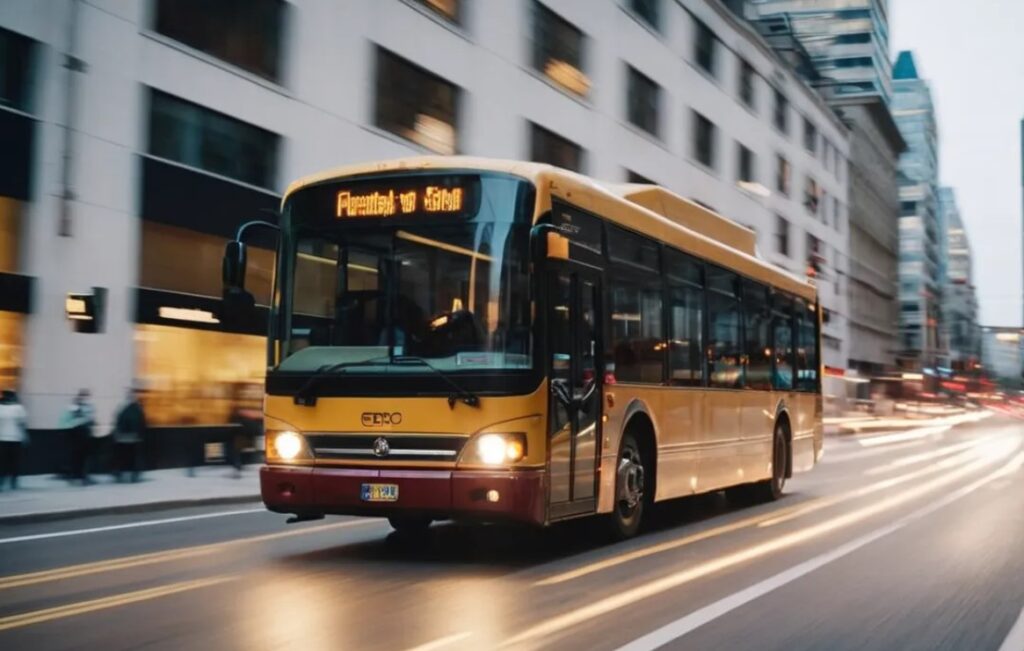How Fast Does A Bus Go? Everything You Need To Know
In the quest to understand How Fast Does A Bus Go? it’s crucial to delve into various factors that influence bus speeds. These factors range from the type of bus to the conditions under which it’s operating.
Key Takeaways
- Average Speed: The average speed of city buses and highway buses.
- Factors Affecting Speed: Influences such as bus type, traffic, and regulations.
- Speed Variations: Differences in speed based on bus models and usage.
- Safety Concerns: How speed impacts safety in bus travel.
- Efficiency and Time: The role of speed in overall travel efficiency.
How Fast Does A Bus Go?
Creating a comprehensive list of all types of buses along with their respective speed ranges provides a clear understanding of the diversity in bus transportation. Here’s a detailed list:

- City Buses
- Average Speed: 10-15 mph (16-24 km/h)
- These buses operate in urban areas with frequent stops and heavy traffic, which limits their speed.
- Intercity Buses
- Average Speed: 60-70 mph (97-113 km/h)
- Designed for travel between cities, these buses reach higher speeds on highways.
- School Buses
- Average Speed: 45-55 mph (72-88 km/h)
- Top Speed Limit: 65-70 mph (104-113 km/h)
- School buses prioritize safety and have lower operational speeds, especially in residential and school zones.
- Double-Decker Buses
- Average Speed: 10-15 mph (16-24 km/h) in cities; up to 60 mph (97 km/h) on open roads
- Common in tourist and urban areas, their speed varies significantly based on location.
- Electric Buses
- Average Speed: Similar to their diesel counterparts, around 10-15 mph (16-24 km/h) in urban areas and up to 70 mph (113 km/h) on highways
- Electric buses have comparable speeds to traditional buses but offer quicker acceleration.
- Mini Buses
- Average Speed: 30-40 mph (48-64 km/h)
- Often used for shuttle services, their speed is subject to the type of service and road conditions.
- Tourist Coaches
- Average Speed: 60-70 mph (97-113 km/h)
- These are designed for long-distance travel with fewer stops, allowing for higher speeds.
- Articulated Buses
- Average Speed: 12-20 mph (19-32 km/h) in cities
- These longer buses, used in urban public transport, have speeds similar to standard city buses.
- Trolleybuses
- Average Speed: 10-15 mph (16-24 km/h)
- Powered by overhead electric wires, their speed is comparable to regular city buses.
- Airport Shuttle Buses
- Average Speed: 25-30 mph (40-48 km/h)
- These buses operate within airport premises and have speed limits for safety reasons.
- Luxury Coaches
- Average Speed: 55-65 mph (88-105 km/h)
- Used for long-distance, comfortable travel, they maintain high speeds on highways.
- BRT (Bus Rapid Transit) Systems
- Average Speed: 20-30 mph (32-48 km/h)
- BRT buses operate in dedicated lanes, allowing for faster speeds than regular city buses.
This list provides a general idea of the speeds various bus types can achieve. However, the actual speed of a bus at any given time depends on several factors including traffic conditions, road types, and local regulations.
Factors Influencing Bus Speed
Type of Bus
Different bus models are designed for varied purposes, affecting their speed. City buses prioritize safety and accessibility over speed, while long-distance coaches are built for faster travel.
Traffic and Regulations
Traffic congestion significantly reduces bus speed, especially in urban areas. Additionally, regulatory speed limits set by local authorities dictate the maximum speed buses can legally travel.
Speed Variations Among Bus Models

City vs. Long-Distance Buses
The design and engineering of city buses and long-distance buses differ, leading to notable speed variations. Long-distance buses are generally faster due to their streamlined design and powerful engines.
Manufacturer Specifications
Bus speeds also vary based on the manufacturer’s specifications. Some buses are built with more powerful engines, enabling higher top speeds.
Safety Considerations in Bus Speed
High speeds can pose safety risks, especially in densely populated areas. Buses are designed to balance speed with safety, ensuring passenger and pedestrian safety remains a top priority.
Efficiency and Travel Time
Speed directly impacts the efficiency of bus travel. Faster buses reduce travel time, making them an attractive option for long-distance travel. However, in city scenarios, the focus is more on consistent service rather than speed.
What Is The Average Speed Of A Bus?
The average speed of a bus varies significantly depending on its type and operating environment. For city buses, the average speed typically ranges from 10-15 mph (16-24 km/h).
This is due to the frequent stops they make, traffic congestion, and urban speed limits which are designed to ensure the safety of passengers and pedestrians.

On the other hand, highway buses, which travel longer distances with fewer stops, generally average between 60-70 mph (97-113 km/h) on open roads, subject to the regional speed limits.
This difference in speed is attributed to their different roles; city buses focus on accessibility within urban areas, while highway buses emphasize efficiency over longer distances.
What Is The Top Speed Of A School Bus?
The top speed of a school bus is typically lower than other types of buses due to stringent safety regulations. In the United States, most school buses have a top speed that is electronically limited to around 65-70 mph (104-113 km/h).

However, it’s important to note that school buses rarely travel at these top speeds. The operational speed is often much lower, usually around 45-55 mph (72-88 km/h), especially when transporting students.
This reduced speed is a precautionary measure to ensure the safety of child passengers, considering the frequent stops and starts school buses make on their routes, often in residential areas and school zones where lower speed limits are enforced.
How Fast Is The Bus In Speed?
The phrase “How fast is the bus in speed?” can be interpreted in a few ways, but generally, it refers to the operating speed of a bus under normal conditions.
As previously mentioned, city buses operate at an average speed of 10-15 mph (16-24 km/h) in urban areas, mainly due to traffic, frequent stops, and urban speed limits.
In contrast, highway buses can operate at higher speeds, typically averaging 60-70 mph (97-113 km/h) when on open roads and intercity routes.
These speeds are influenced by factors such as bus type, traffic conditions, road type, and legal speed limits. It’s important to note that the actual speed of a bus at any given time will depend on these various factors, and the mentioned speeds are average estimates under normal operating conditions.
Conclusion
In summary, how fast a bus goes depends on a multitude of factors, including the type of bus, traffic conditions, and legal regulations. While city buses prioritize safety and accessibility, leading to slower speeds, highway buses are designed for efficiency and faster travel. Understanding these nuances provides clarity on what to expect from bus travel in different contexts.
Top FAQ’s
Can weather conditions influence how fast a bus goes?
Adverse weather conditions like rain, snow, or fog can lead to reduced speeds for safety reasons. Buses may travel slower to ensure safe operation and passenger comfort during such conditions.
Does bus speed affect fuel efficiency?
Yes, speed can impact fuel efficiency. Generally, maintaining a consistent, moderate speed is more fuel-efficient than frequent speeding up and slowing down, especially in heavy traffic conditions.
How do electric buses compare in speed to diesel buses?
Electric buses can achieve speeds similar to diesel buses. However, their acceleration might be quicker due to the nature of electric motors. The top speed is usually limited for safety and efficiency reasons, similar to diesel buses.
Is bus speed affected by the number of stops it makes?
Definitely. The more stops a bus makes, the lower its average speed will be. This is particularly noticeable in city buses, where frequent stops for passengers lead to reduced overall speed.

Welcome to the exhilarating world of Matt Rex, a professional car racer turned renowned vehicle enthusiast. Immerse yourself in his captivating blog as he shares heart-pounding adventures, expert reviews, and valuable insights on cars, trucks, jets, and more. Fuel your passion for speed and discover the beauty of vehicles through Matt’s engaging stories and meticulous expertise. Join the ever-growing community of enthusiasts who find inspiration and expert advice in Matt Rex’s blog—a digital hub where the thrill of speed meets the pursuit of knowledge.







